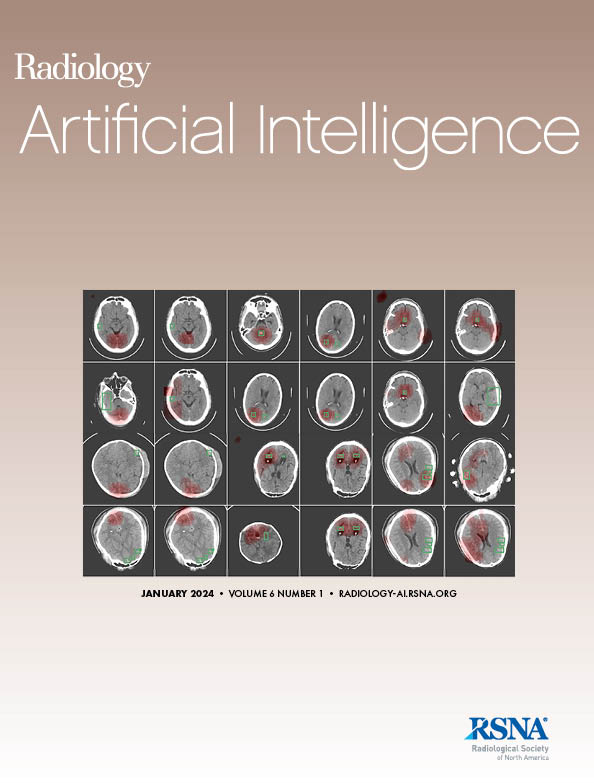Pseudo-Contrast-enhanced US via Enhanced Generative Adversarial Networks for Evaluating Tumor Ablation Efficacy.
IF 13.2
Q1 COMPUTER SCIENCE, ARTIFICIAL INTELLIGENCE
Chen Chen, Jiabin Yu, Zhikang Xu, Changsong Xu, Zubang Zhou, Jindong Hao, Vicky Yang Wang, Jincao Yao, Lingyan Zhou, Chenke Xu, Mei Song, Qi Zhang, Xiaofang Liu, Lin Sui, Yuqi Yan, Tian Jiang, Yahan Zhou, Yingtianqi Wu, Binggang Xiao, Chenjie Xu, Hongmei Mi, Li Yang, Zhiwei Wu, Qingquan He, Jian Chen, Qi Liu, Dong Xu
求助PDF
{"title":"Pseudo-Contrast-enhanced US via Enhanced Generative Adversarial Networks for Evaluating Tumor Ablation Efficacy.","authors":"Chen Chen, Jiabin Yu, Zhikang Xu, Changsong Xu, Zubang Zhou, Jindong Hao, Vicky Yang Wang, Jincao Yao, Lingyan Zhou, Chenke Xu, Mei Song, Qi Zhang, Xiaofang Liu, Lin Sui, Yuqi Yan, Tian Jiang, Yahan Zhou, Yingtianqi Wu, Binggang Xiao, Chenjie Xu, Hongmei Mi, Li Yang, Zhiwei Wu, Qingquan He, Jian Chen, Qi Liu, Dong Xu","doi":"10.1148/ryai.240370","DOIUrl":null,"url":null,"abstract":"<p><p>Purpose To develop methods for creating pseudo-contrast-enhanced US (CEUS) by using an enhanced generative adversarial network and evaluate its ability to assess tumor ablation effectiveness. Materials and Methods This retrospective study included 1030 patients who underwent thyroid nodule ablation across seven centers from January 2020 to April 2023. A generative adversarial network-based model was developed for direct pseudo-CEUS generation from B-mode US and tested on thyroid, breast, and liver ablation datasets. The reliability of pseudo-CEUS was assessed using structural similarity index (SSIM), color histogram correlation, and mean absolute percentage error against real CEUS. Additionally, a subjective evaluation system was devised to validate its clinical value. The Wilcoxon signed rank test was employed to analyze differences in the data. Results The study included 1030 patients (mean age, 46.9 years ± 12.5 [SD]; 799 female and 231 male patients). For internal test set 1, the mean SSIM was 0.89 ± 0.05, while across external test sets 1-6, mean SSIM values ranged from 0.84 ± 0.08 to 0.88 ± 0.04. Subjective assessments affirmed the method's stability and near-realistic performance in evaluating ablation effectiveness. The thyroid ablation datasets had an average identification score of 0.49 (0.5 indicates indistinguishability), while the similarity average score for all datasets was 4.75 out of 5. Radiologists' assessments of residual blood supply were nearly consistent, with no differences in defining ablation zones between real and pseudo-CEUS. Conclusion The pseudo-CEUS method demonstrated high similarity to real CEUS in evaluating tumor ablation effectiveness. <b>Keywords:</b> Ablation Techniques, Ultrasound, Computer Applications-Virtual Imaging <i>Supplemental material is available for this article.</i> © RSNA, 2025.</p>","PeriodicalId":29787,"journal":{"name":"Radiology-Artificial Intelligence","volume":" ","pages":"e240370"},"PeriodicalIF":13.2000,"publicationDate":"2025-05-01","publicationTypes":"Journal Article","fieldsOfStudy":null,"isOpenAccess":false,"openAccessPdf":"","citationCount":"0","resultStr":null,"platform":"Semanticscholar","paperid":null,"PeriodicalName":"Radiology-Artificial Intelligence","FirstCategoryId":"1085","ListUrlMain":"https://doi.org/10.1148/ryai.240370","RegionNum":0,"RegionCategory":null,"ArticlePicture":[],"TitleCN":null,"AbstractTextCN":null,"PMCID":null,"EPubDate":"","PubModel":"","JCR":"Q1","JCRName":"COMPUTER SCIENCE, ARTIFICIAL INTELLIGENCE","Score":null,"Total":0}
引用次数: 0
引用
批量引用
Abstract
Purpose To develop methods for creating pseudo-contrast-enhanced US (CEUS) by using an enhanced generative adversarial network and evaluate its ability to assess tumor ablation effectiveness. Materials and Methods This retrospective study included 1030 patients who underwent thyroid nodule ablation across seven centers from January 2020 to April 2023. A generative adversarial network-based model was developed for direct pseudo-CEUS generation from B-mode US and tested on thyroid, breast, and liver ablation datasets. The reliability of pseudo-CEUS was assessed using structural similarity index (SSIM), color histogram correlation, and mean absolute percentage error against real CEUS. Additionally, a subjective evaluation system was devised to validate its clinical value. The Wilcoxon signed rank test was employed to analyze differences in the data. Results The study included 1030 patients (mean age, 46.9 years ± 12.5 [SD]; 799 female and 231 male patients). For internal test set 1, the mean SSIM was 0.89 ± 0.05, while across external test sets 1-6, mean SSIM values ranged from 0.84 ± 0.08 to 0.88 ± 0.04. Subjective assessments affirmed the method's stability and near-realistic performance in evaluating ablation effectiveness. The thyroid ablation datasets had an average identification score of 0.49 (0.5 indicates indistinguishability), while the similarity average score for all datasets was 4.75 out of 5. Radiologists' assessments of residual blood supply were nearly consistent, with no differences in defining ablation zones between real and pseudo-CEUS. Conclusion The pseudo-CEUS method demonstrated high similarity to real CEUS in evaluating tumor ablation effectiveness. Keywords: Ablation Techniques, Ultrasound, Computer Applications-Virtual Imaging Supplemental material is available for this article. © RSNA, 2025.
伪对比增强US通过增强生成对抗网络评估肿瘤消融疗效。
“刚刚接受”的论文经过了全面的同行评审,并已被接受发表在《放射学:人工智能》杂志上。这篇文章将经过编辑,布局和校样审查,然后在其最终版本出版。请注意,在最终编辑文章的制作过程中,可能会发现可能影响内容的错误。目的:开发一种使用增强型生成对抗网络创建伪对比增强超声(CEUS)的方法,并评估其评估肿瘤消融效果的能力。材料和方法本回顾性研究纳入了2020年1月至2023年4月在7个中心接受甲状腺结节消融治疗的1030例患者。开发了基于生成对抗网络的模型,用于从b模式US直接生成伪ceus,并在甲状腺、乳房和肝脏消融数据集上进行了测试。采用结构相似指数(SSIM)、颜色直方图相关性(CHC)和相对于真实CEUS的平均绝对百分比误差(MAPE)来评估伪CEUS的可靠性。此外,还设计了一个主观评价系统来验证其临床价值。采用Wilcoxon符号秩检验分析数据差异。结果纳入1030例患者,平均年龄46.9岁±12.5岁;799名女性和231名男性)。内部测试集1的平均SSIM为0.89±0.05,而外部测试集1-6的平均SSIM值为0.84±0.08至0.88±0.04。主观评价肯定了该方法在评估消融效果方面的稳定性和接近真实的性能。甲状腺消融数据集的平均识别得分为0.49(0.5表示无法区分),而所有数据集的相似度平均得分为4.75(满分5分)。放射科医生对残余血供的评估几乎一致,在确定真超声和假超声消融区域方面没有差异。结论伪超声造影与真超声造影在评价肿瘤消融效果方面具有较高的相似性。在CC BY 4.0许可下发布。
本文章由计算机程序翻译,如有差异,请以英文原文为准。

 求助内容:
求助内容: 应助结果提醒方式:
应助结果提醒方式:


